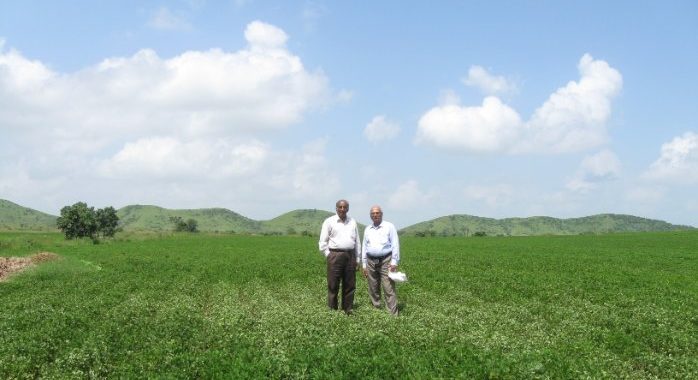by Dr. M. S. Basu
India is the second largest groundnut producing country in the world, next to China. The production systems and situations are quite diverse and the crop is grown almost round the year. The crop-weather situations, therefore, varies from high temperature (40-45°C), scanty rainfall (450-500 mm) areas to low temperature (20-25°C), high rainfall (1500-2000 mm) areas that supports very high to negligible Aflatoxin in produce.
Anantpur district of Andhra Pradesh is considered to be the world’s largest groundnut growing District with estimated per capita consumption as high as 70 g/day. But at the same time, there is high risk of Aflatoxin contamination both at pre and post harvest stages. Aflatoxin content in fresh harvest from Anantpur often goes beyond 50 ppb and moves up rapidly along with the length of storage (>100 ppb). This has serious impact on human and animal health since Aflatoxin is carcinogenic as well as immunosuppressive in nature. In India, although the safe level of Aflatoxin has been kept at 30 ppb but the European standard is as stringent as 2 ppb (B1); whereas it varies between 5-15 ppb in most of the developed countries.
Cultural Practices:
To address this very crucial issue, 5 villages in Anantpur district were identified based on severity of the problem and other socio-economic aspects related to groundnut cultivation. The critical factors responsible for Aflatoxin contamination at farm and storage levels were identified and their impact studied through farmers’ participatory mode. Afterwards, validation of those components having bearing on Aflatoxin was made through On-Farm Demonstration for over 3 years. By integrating couple of key management factors at the pre and post harvest levels it was possible to demonstrate negligible Aflatoxin contamination (0-5 ppb) in that high risk areas even after 3-6 months of ordinary storage at household level. In 75% cases, the Aflatoxin contamination levels were <15 ppb in 5 villages adopted under the special project generously supported by the UNDP, New Delhi.
Biological Control:
Aflatoxin contamination in groundnut, caused by A. flavus group of fungi, is a major problem in the rainfed agriculture in the semi-arid tropics. Biological control could be one of the components of integrated management to reduce pre-harvest kernel infection in the field.
The concept of biological control by competitive exclusion of A. flavus is a promising component of the integrated management of Aflatoxin contamination in groundnut. Bio-control of Aflatoxin contamination involves the use of competitive and antagonistic native microorganisms that can reduce the populations of Afla-toxigenic strains present in the soil, and subsequently reduce infection to the developing pods and kernels of groundnut. The entry of A. flavus to the developing groundnut is directly from the soil surrounding it. Biological control could be one of the components of integrated management to reduce pre-harvest kernel infection in the field.
A number of potential strains of fungal and bacterial cultures antagonistic to A. flavushave been isolated from rhizosphere of groundnut. Fluorescent pseudomonades are prominent inhabitants in the rhizosphere of many crop plants and these have been identified as promising bio-control agents against A. flavus contamination in groundnut. Varying levels of successes was achieved in containing Aflatoxin by using non-toxigenic strains. On some occasions Aflatoxin levels in groundnuts was reduced by 95% compared with controls.
The advantages of using bio-control agents include minimal disturbance of the ecosystem, positive consumer perception/acceptance, no trans-gene implicating food safety regulations, and the potential of readily transferable low cost technology to other countries. Integration of these bio-control agents with genetic host resistance, and agronomic management would greatly help in reducing Aflatoxin contamination in groundnut, a major problem affecting the export and earning of foreign exchange in the developing countries.
For more details consult the Bulletin on “Aflatoxin Management in Groundnut” authored by Dr. M. S. Basu, Principal Investigator &Formerly Director, National Research Centre for Groundnut (ICAR)and published by UNDP, New Delhi and Dept. of Agriculture & Cooperation, Ministry of Agriculture, Govt. of India.

